
The Mare Island Naval Shipyard was the first United States Navy base established on the Pacific Ocean and was in service 142 years from 1854 to 1996. It is located on Mare Island, 23 miles (37 km) northeast of San Francisco, in Vallejo, California. MINSY made a name for itself as the premier U.S. West Coast submarine port as well as serving as the controlling force in San Francisco Bay Area shipbuilding efforts during World War II.

John Drake Sloat was a commodore in the United States Navy who, in 1846, claimed California for the United States.
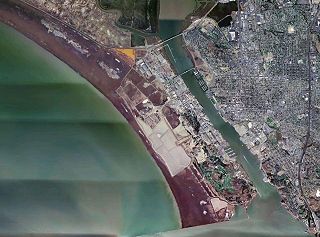
Mare Island is a peninsula in the United States in the city of Vallejo, California, about 23 miles (37 km) northeast of San Francisco. The Napa River forms its eastern side as it enters the Carquinez Strait juncture with the east side of San Pablo Bay. Mare Island is a peninsula, as no full body of water separates this or several other named "islands" from the mainland. Instead, a series of small sloughs cause seasonal water-flows among the so-called islands. Mare Island is the largest of these at about 3.5 miles (5.6 km) long and a mile wide.
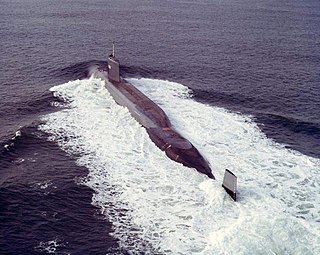
USS Mariano G. Vallejo (SSBN-658), was a Benjamin Franklin-class fleet ballistic missile submarine, was named for Mariano Guadalupe Vallejo (1807–1890), a key proponent of California statehood. The boat's service extended from 1966 until 1995.

Stanford Memorial Church is located on the Main Quad at the center of the Stanford University campus in Stanford, California, United States. It was built during the American Renaissance by Jane Stanford as a memorial to her husband Leland. Designed by architect Charles A. Coolidge, a student of Henry Hobson Richardson, the church has been called "the University's architectural crown jewel".

The Wellington Cathedral of St Paul, also called St Paul's Cathedral or Wellington Cathedral, is an Anglican cathedral church located on Hill Street, at its junction with Molesworth Street, in Thorndon, in the city of Wellington, New Zealand. It is situated close to the parliament precinct.

Vincent Robert Capodanno Jr., M.M. was a Catholic priest and Maryknoll Missioner killed in action while serving as a Navy chaplain with a Marine Corps infantry unit during the Vietnam War. He was a posthumous recipient of America's highest military decoration, the Medal of Honor, for heroic actions above and beyond the call of duty. The Catholic Church has declared him a Servant of God, the first of the four stages toward possible sainthood.

The Garden Island Naval Chapel is a heritage-listed non-denominational Christian chapel located in the heritage-listed Garden Island Naval Precinct that comprises a naval base and dockyard in the inner eastern Sydney suburb of Garden Island in the City of Sydney local government area of New South Wales, Australia.

Cathedral Church of St Michael and St George serves as the Roman Catholic cathedral for the Bishopric of the Forces. Located on Queens Avenue in Aldershot, England, the building was originally intended to be the principal church for the Anglican chaplaincies of the British Army but since 1973 it has been the seat of the Roman Catholic Bishop of the Forces.

The United States Naval Academy Chapel in Annapolis, Maryland, is one of nine designated chapel spaces on the grounds of the United States Navy's service academy. Protestant and Catholic services are held there. The Brigade Chapel is a focal point of the Academy and the city of Annapolis. The chapel is an important feature which led to the Academy being designated a National Historic Landmark in 1961.
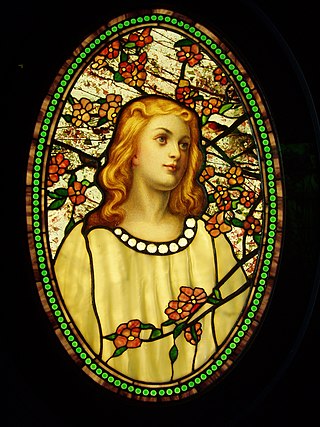
Tiffany glass refers to the many and varied types of glass developed and produced from 1878 to 1929-1930 at the Tiffany Studios in New York City, by Louis Comfort Tiffany and a team of other designers, including Clara Driscoll, Agnes F. Northrop, and Frederick Wilson.
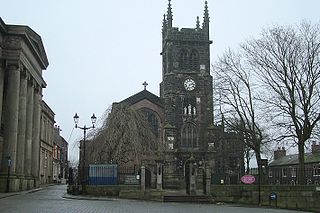
St Michael and All Angels Church overlooks Market Place in the town of Macclesfield, Cheshire, England. It is an active Anglican parish church in the diocese of Chester, the archdeaconry of Macclesfield and the deanery of Macclesfield. It forms a team parish with three other Macclesfield churches: All Saints, St Peter's and St Barnabas'. The church is recorded in the National Heritage List for England as a designated Grade II* listed building.

St George's Cathedral is the Anglican cathedral in Cape Town, South Africa, and the seat of the Archbishop of Cape Town. St. George's Cathedral is both the metropolitical church of the Anglican Church of Southern Africa and a congregation in the Diocese of Cape Town.
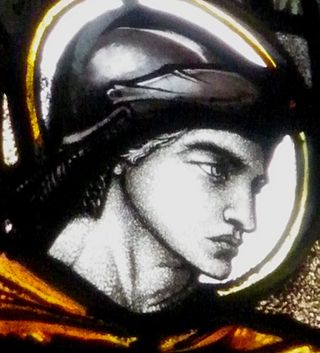
Rachel de Montmorency, née Rachel Marion Tancock, was an English painter and artist working in stained glass. She learned about stained glass when she worked for artist Christopher Whall in the 1910s and 1920s. During World War I she worked as a voluntary nurse.

Faith Chapel is a historic chapel on Old Plantation Road in Jekyll Island, Georgia and was built in 1904. It was used as a non-denominational chapel until 1942. The state of Georgia purchased it along with Jekyll Island in 1947. It is administered by the Jekyll Island State Park Authority and was opened to the public in 1970. It has a wood "A" frame and a brick foundation. The interior and exterior walls are shingled, with gargoyles that are replicas of the ones at Notre Dame Cathedral. The chapel was added to the National Register of Historic Places in 1971 and it is open to the public.

St Mihangel's Church in the village of Llanfihangel yn Nhowyn is a former parish church now used as the chapel for RAF Valley in Anglesey, north Wales. The date of the first church on the site is uncertain, but in 1862 the then-existing church was rebuilt. St Mihangel's became the chapel for the nearby Royal Air Force base in 1998, after the Church in Wales had ceased using it for services. It was then extended by dismantling and reassembling another Anglesey church, St Enghenedl's, at the west end of the building.

First Presbyterian Church is a congregation of the Presbyterian Church (U.S.A) located in downtown Springfield, Illinois. This is the church that President Abraham Lincoln and his family attended while they lived in Springfield.

Mare Island Naval Shipyard Airfield was a post-World War 1 US Navy airfield that opened around 1922 and closed in 1937 at Mare Island Naval Shipyard in the city of Vallejo, California. The airfield was located at 13th Street & Flagship Drive on the naval base, just west of the Marine Barracks. The airfield had a single unpaved runway for day use only. Common aircraft at the airfield were Vought FU, Vought VE-7 and Curtiss JN-4 Jenny.

St. Mary's-in-Tuxedo Episcopal Church, otherwise simply referred to as St. Mary's-in-Tuxedo, is an active Episcopal church in Tuxedo, New York, located within the historic village of Tuxedo Park.

Albert Sutton was a noted architect in the Pacific Northwest, especially in the cities of Tacoma, Washington; San Francisco, California; Portland, Oregon; and their vicinities. Apart from his first 8 years in San Francisco, he thrived working with his architectural partners: James Pickles for 7 years in Tacoma, Charles P. Weeks for 7 years in San Francisco, and Harrison A. Whitney for 11 years in Portland, prior to his sudden untimely death.
























